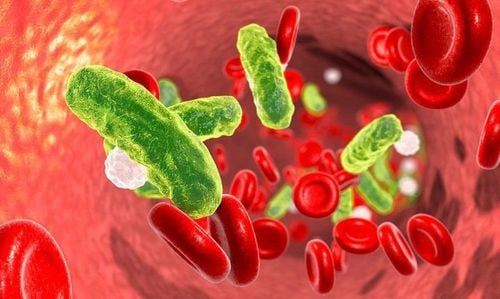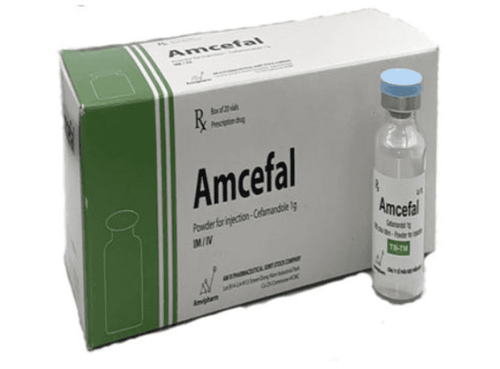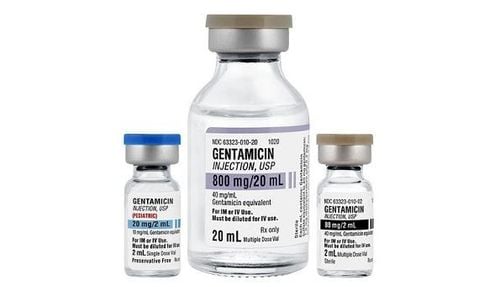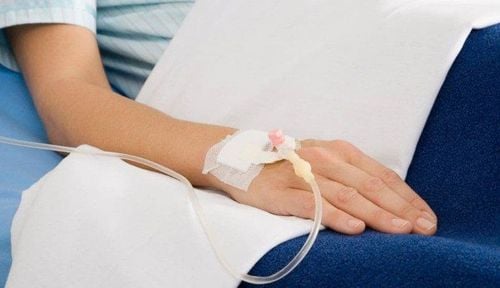This is an automatically translated article.
The article was written by Dr. Truong Ngoc Hai - Resuscitation Doctor - Emergency Department - Vinmec Central Park International General HospitalAppropriate fluid resuscitation improves tissue perfusion and improves shock. Tissue hypoperfusion due to NKH manifests as organ dysfunction and hyperlactateemia, which may be accompanied by hypotension.
Sepsis is a global challenge with an estimated 20-30 million deaths each year worldwide [3],[22]. The mortality rate is still very high, accounting for about 50% in patients with septic shock [17]. The costs associated with the care and treatment of patients with septic shock/septic shock are a major medical burden in many countries [3]. Treatment of septic shock/septic shock still focuses on fluid resuscitation, antibiotic use, infection control, and vasopressor therapy [19]. Fluid resuscitation or, more specifically, fluid balance therapy remains controversial, although mortality is markedly improved with fluid therapy [7], [42].
NKH/shock NKH is often associated with effective intravascular volume depletion due to decreased fluid intake, increased fluid loss, loss of third-space fluid, and vasodilation. Fluid resuscitation is often a necessary treatment to increase cardiac output and improve tissue perfusion. However, over-aggressive fluid administration can lead to increased mortality from complications of fluid overload [1], [8], [18], [24], [47], [50]. Therefore, fluid resuscitation should only be performed in patients who are still responding to fluids. Methods to predict fluid response are not commonly used clinically when rehydrating patients [12]. Part of the reason may be that signs of fluid response are not easy to assess and all hemodynamic monitoring techniques have limitations.
To address this problem, recent recommendations indicate that fluid resuscitation should be approached in four phases: lifesaving, optimization, stabilization, and de-escalation [49]. The above recommendation helps us to know the goal of fluid balance but does not specify how much fluid is needed at each stage. An increasing number of studies show that continuing positive fluid balance after the resuscitation phase increases mortality in patients with septic shock/septic shock [50],[7]. Currently, the recommendation does not specify the right time to switch from positive to negative fluid balance.

1. Components of fluid balance
Fluid balance is the difference between fluid input and output, but the components can change dynamically during treatment. Currently, we do not have data on fluid balance after the first week of NKH, as most studies have focused on the first 7 to 8 days in the ICU or hospital stay.In daily clinical practice, the amount of fluid output is mostly urine, drainage fluid, and ultrafiltration fluid during dialysis, while the rest is a small amount of unknowingly lost water such as sweat, breath, and blood loss. through the skin. Only a handful of studies have examined urine output. Two studies reporting urine output noted no difference in urine output between living and dead patients [1], [8]. More importantly, when a positive fluid balance occurs, it is mostly due to increased fluid intake. Therefore, fluid resuscitation is considered as the most effective modifier to prevent fluid overload.
The FACTT (Fluids and Catheters Treatment Trial) study classified patients according to CVP level at admission to HSTC. In patients with CVP values greater than 8 mmHg, the difference in treatment between the two groups of patients who survived and died was mainly due to the use of diuretics. Diuretic use was not associated with increased mortality. However, in patients with CVP values below 8 mmHg, the difference between the two groups of survival and death was mainly due to fluid balance. Intensive fluid resuscitation was associated with increased mortality in patients with CVP less than 8 mmHg in multivariate analysis [45]. In addition, in patients receiving intravenous fluids according to the regimen, only 23% of resuscitation sessions were considered to be fluid responsive. This supports the view that previously resuscitated patients may not benefit from additional fluid resuscitation and that CVP is a poor predictor of fluid response.
Fluids can be infused for hemodynamic or non-hemodynamic purposes. When administering anti-shock fluids, the volume of fluid needed to resuscitate for hemodynamic purposes tends to decrease gradually since admission to the Department of General Surgery. In contrast, the volume of fluids that are not used for hemodynamic purposes such as nutrition, drugs, and other hemodynamic goals. Blood products increased gradually since entering the Department of HSTC. Both should be taken into account when determining a reasonable and long-term fluid administration strategy for each patient.
A concern is that most rapid fluid resuscitation tests are performed without any means of assessing fluid response. Nearly one third of intravascular volume expansion patients did not benefit from fluid resuscitation according to the 2016 SSC guidelines [11]. Several recent trials suggest fluid resuscitation according to dynamic parameters to assess fluid response [15]. This can help reduce unnecessary fluid volume, provide benefits later, reduce the potential for fluid overload, and reduce the amount of fluid that needs to be removed at later stages.
2. Phases of fluid balance
Vincent and De Backer [49] proposed a treatment goal for each stage in patients with shock. This proposal was adopted by the 12th ADQI on epidemic management in critically ill patients. This model defines four therapeutic stages of shock: (1) Life-saving stage, the goal of which is the minimum acceptable blood pressure to sustain life; (2) Optimal phase, with the goal of increasing cardiac output in proportion to organ demand; (3) The stabilization phase, focusing mainly on support and prevention of complications; and (4) The de-escalation phase, when it is assessed that the patient should be released from the ICU.During the life-saving and optimization phase of septic shock, fluid intake is likely to exceed output, the goal being to improve organ perfusion. During the life-saving phase, empiric fluid resuscitation is preferred. In the optimal setting, the life-threatening condition is usually under control, but compensated shock may persist; conservative fluid resuscitation is indicated and guided by hemodynamic parameters to avoid compensation. Translation is not required.
During the stable phase, patients may experience anuria as well as other organ system dysfunction. In the stable phase, it is clear that rehydration is not beneficial. The main treatment in this stage is to support organ function. Volumes not used for hemodynamic support should be kept to a minimum [15]. A negative fluid balance should be targeted using diuretics. For patients requiring renal replacement therapy, ultrafiltration should be adjusted to achieve the desired fluid balance. Finally, during the de-escalation phase, a negative fluid balance should be aimed at restoring and preventing undesirable effects of fluid overload. In summary, negative fluid balance should be considered the goal during stabilization and de-escalation [49]. Whether neutral fluid balance during the optimal period is beneficial is still unclear.
3. How to achieve negative fluid balance in sepsis
Although fluid resuscitation is essential in the treatment of patients with NKH/septic shock in the life-saving and optimization stage. EGDT often leads to fluid overload, causing more harm to the patient than good. Fluid therapy has a narrow therapeutic window and soon loses its hemodynamic improvement. Therefore, some authors suggest the early use of vasopressors to treat hypotension due to NKH after 20 to 25 ml/kg compensation during the first hour of resuscitation. In fact, studies have shown that the use of norepinephrine (< 2 hours after septic shock) reduces the duration of hypotension and reduces mortality [4].Randomized controlled clinical trials of EGDT in NKH (ProCESSS trial [52], ARISE [38], ProMIse [35]) infused approximately 50 to 60 mL/Kg of fluid during the first 6 hours of septic shock. Several authors suggested that most fluid resuscitation had no hemodynamic benefit in these clinical trials. These studies used CVP to guide fluid resuscitation. CVP is a static parameter, capable of assessing the patient's fluid response very poorly. Therefore, the recommendation of the SSC in 2018 has completely eliminated CVP from EGDT.
During stabilization and de-escalation, it is safe to use diuretics or dialysis with ultrafiltration to achieve negative fluid balance. Although the regimen does not allow a combination of diuretics and vasopressors, using diuretics to achieve negative fluid balance in patients on vasopressors is unlikely to have any adverse complications. The safety of diuretics in patients receiving vasopressors was demonstrated in the FACTT trial [51]. Therefore, in our opinion, negative or zero fluid balance can be achieved in patients receiving low-dose vasopressors during the stable phase, as long as tissue perfusion is ensured. This issue is still being proven.
However, despite the approach of using diuretics or dialysis to achieve negative fluid balance, the fear of excessive fluid withdrawal is still worthy of attention. The goal of treatment is to remove the interstitial fluid overload, but in fact, the intravascular fluid is eliminated first. Experts believe that hypotension will not occur when the rate of fluid reabsorption from the interstitium is commensurate with the rate of fluid removal. However, the rate at which fluid reabsorption from the interstitial tissue occurs is currently unknown. Most of the observational studies suggest that fluid withdrawal is increased hourly to find the optimal volume of fluid to be withdrawn. Marenzi et al. [30] demonstrated that fluid withdrawal in edematous patients at a rate of 500 ml/hr was possible without hemodynamic effects in patients with heart failure. Flythe et al [21] showed that fluid withdrawal rates higher than 10 ml/Kg/hour were associated with mortality. The evidence for outpatient dialysis favors a low and progressive withdrawal rate to allow time for fluid to migrate from the interstitium and the endovascular space.
The goal of negative fluid balance can be achieved with diuretics or dialysis. In addition to the goal of fluid balance, we must also include the patient's renal function status. Diuretics are preferred first if no solute target is needed (eg, uremia syndrome or significant hyperkalemia) in patients with renal impairment. However, if diuretics are used and the patient remains anuria or has worsening renal failure (hyperkalemia, metabolic acidosis, uremia) or uncontrolled fluid overload, dialysis should be initiated.
In summary, fluid balance in patients with septic shock/shock is a kinetic process that changes over time. Depending on the stage of the disease, we have different fluid balance treatment strategies. In the early stages of septic shock/septic shock, inadequate fluid resuscitation will cause lack of perfusion to organs, leading to multi-organ failure. On the contrary, in the late stage, positive fluid balance adversely affects the function of organs due to circulatory overload and organ congestion. However, the progress from early stage to late stage and when is the transition period is almost never clear from any research.
Please dial HOTLINE for more information or register for an appointment HERE. Download MyVinmec app to make appointments faster and to manage your bookings easily.













